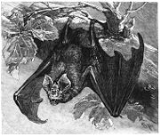
Sakeji Horseshoe Bat
Encyclopedia
The Sakeji Horseshoe Bat (Rhinolophus sakejiensis) is a species of bat
in the Rhinolophidae family. It is endemic to Zambia
. Its natural habitat
s are subtropical or tropical dry forest
s, subtropical or tropical moist lowland forests, and moist savanna
, especially Zambia, Mwinilunga District, Ikelenge Pedicle between the Sakeji and Zambezi Rivers, approx. 11 km NNE of source of Zambezi River, Kavunda, 11°17'S, 24°21'E, 1,388 m. It is threatened by habitat loss. It was discovered in 2000
Bat
Bats are mammals of the order Chiroptera "hand" and pteron "wing") whose forelimbs form webbed wings, making them the only mammals naturally capable of true and sustained flight. By contrast, other mammals said to fly, such as flying squirrels, gliding possums, and colugos, glide rather than fly,...
in the Rhinolophidae family. It is endemic to Zambia
Zambia
Zambia , officially the Republic of Zambia, is a landlocked country in Southern Africa. The neighbouring countries are the Democratic Republic of the Congo to the north, Tanzania to the north-east, Malawi to the east, Mozambique, Zimbabwe, Botswana and Namibia to the south, and Angola to the west....
. Its natural habitat
Habitat
* Habitat , a place where a species lives and grows*Human habitat, a place where humans live, work or play** Space habitat, a space station intended as a permanent settlement...
s are subtropical or tropical dry forest
Forest
A forest, also referred to as a wood or the woods, is an area with a high density of trees. As with cities, depending where you are in the world, what is considered a forest may vary significantly in size and have various classification according to how and what of the forest is composed...
s, subtropical or tropical moist lowland forests, and moist savanna
Savanna
A savanna, or savannah, is a grassland ecosystem characterized by the trees being sufficiently small or widely spaced so that the canopy does not close. The open canopy allows sufficient light to reach the ground to support an unbroken herbaceous layer consisting primarily of C4 grasses.Some...
, especially Zambia, Mwinilunga District, Ikelenge Pedicle between the Sakeji and Zambezi Rivers, approx. 11 km NNE of source of Zambezi River, Kavunda, 11°17'S, 24°21'E, 1,388 m. It is threatened by habitat loss. It was discovered in 2000

